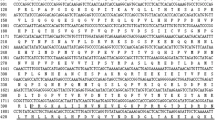Abstract
Calpains are ubiquitous cysteine-proteases found in many, if not all, living organisms and their roles within these organisms are diverse, ranging from the mediation of cytoskeletal remodeling to the regulation of gene expression. In crustaceans calpains have so far been shown to be important mainly during moulting and growth. In the present study we report the expression of a calpain in the abdominal muscle of Norway lobster (Nephrops norvegicus) using degenerate primer, rapid amplification of cDNA ends (5′-3′-RACE), reverse transcriptase-PCR and RNA in situ hybridization approaches. The full-length mRNA sequence (2,774 bp) was found to include an open reading frame (bp 225–1,940) encoding a 572 amino acid polypeptide with a predicted mass of 65.9 kDa and a predicted pI of 5.17. The calpain was found to be an arthropod M-class calpain homologue to Homarus americanus Calpain M (Ha-CalpM) and has thus been termed Nephrops norvegicus calpain M (Nn-CalpM). When its expression pattern in abdominal muscle of adult intermoult Nephrops norvegicus was investigated an exclusive expression in a thin layer of connective tissue cells surrounding muscle fibres was found. This localization suggests a role in tenderizing connective tissue networks during growth and moulting.






Similar content being viewed by others
References
Goll DE, Thompson VF, Li H, Wei W, Cong J (2003) The calpain system. Physiol Rev 83:731–801. doi:10.1152/physrev.00029.2002
Wang JH, Ma WC, Su JC, Chen CS, Jiang ST (1993) Comparison of the properties of m-calpain from Tilapia and grass shrimp muscles. J Agric Food Chem 41:1379–1384. doi:10.1021/jf00033a007
Mykles DL, Skinner DM (1986) Four Ca2+-dependent proteinase activities isolated from crustacean muscle differ in size, net charge, and sensitivity to Ca2+ and inhibitors. J Biol Chem 261:9865–9871
Yu X, Mykles DL (2003) Cloning of a muscle-specific calpain from the American lobster Homarus americanus: expression associated with muscle atrophy and restoration during moulting. J Exp Biol 206:561–575. doi:10.1242/jeb.00097
Medler S, Chang ES, Mykles DL (2007) Muscle-specific calpain is localized in regions near motor endplates in differentiating lobster claw muscle. Comp Biochem Physiol A 148:591–598. doi:10.1016/j.cbpa.2007.08.008
Kim HW, Chang ES, Mykles DL (2005) Three calpains and ecdysone receptor in the land crab Gecarcinus lateralis: sequences, expression and effects of elevated ecdysteroid induced by eyestalk ablation. J Exp Biol 208:3177–3197. doi:10.1242/jeb.01754
Beyette JR, Mykles DL (1997) Autolysis and biochemical properties of a lobster muscle calpainlike proteinase. J Exp Zool 277:106–119
Aiken DE (1980) Moulting and growth. In: Cobb JS, Phillips BF (eds) The biology and management of lobsters, 1st edn. Academic Press, New York and London, pp 91–164
Brown C (1998) In situ hybridization with riboprobes: an overview for veterinary pathologists. Vet Pathol 35:159–167
Braissant OL, Wahli W (1998) A simplified in situ-hybridization protocol using non-radioactively labeled probes to detect abundant and rare mRNAs on tissue sections. Biochemica 1:10–16
Croall DE, Demartino GN (1991) Calcium-activated neutral protease (calpain) system: structure, function, and regulation. Physiol Rev 71:813–847
Croall D, Ersfeld K (2007) The calpains: modular designs and functional diversity. Genome Biol 8:218. doi:10.1186/gb-2007-8-6-218
Sorimachi H, Suzuki K (2001) The structure of calpain. J Biochem 129:653–664
Moldoveanu T, Hosfield CM, Lim D, Elce JS, Jia ZC, Davies PL (2002) A Ca2+ switch aligns the active site of calpain. Cell 108:649–660. doi:10.1016/S0092-8674(02)00659-1
Moldoveanu T, Jia ZC, Davies PL (2004) Calpain activation by cooperative Ca2+ binding at two non-EF-hand sites. J Biol Chem 279:6106–6114. doi:10.1074/jbc.M310460200
Lee HJ, Sorimachi H, Jeong SY, Ishiura S, Suzuki K (1998) Molecular cloning and characterization of a novel tissue-specific calpain predominantly expressed in the digestive tract. Bio Chem 379:175–183
Mykles DL, Skinner DM (1981) Preferential loss of thin filaments during molt-induced atrophy in crab claw muscle. J Ultrastruct Res 75:314–325
Mykles DL, Skinner DM (1985) The role of calcium-dependent proteinases in molt-induced claw muscle atrophy. Prog Clin Biol Res 180:141–150
Kumamoto T, Kleese WC, Cong YJ, Goll DE, Pierce PR, Allen RE (1992) Localization of the Ca2+-dependent proteinases and their inhibitor in normal, fasted, and denervated rat skeletal muscle. Anat Rec 232:60–77
Kinbara K, Sorimachi H, Ishiura S, Suzuki K (1998) Skeletal muscle-specific calpain, p49: structure and physiological function. Biochem Pharmacol 56:415–420. doi:10.1016/S0006-2952(98)00095-1
Taylor RG, Geesink GH, Thompson VF, Koohmaraie M, Goll DE (1995) Is Z-disk degradation responsible for post-mortem tenderization? J Anim Sci 73:1351–1367
Richard I, Broux O, Allamand V, Fougerousse F, Chiannilkulchai N, Bourg N, Brenguier L, Devaud C, Pasturaud P, Roudaut C (1995) Mutations in the proteolytic enzyme calpain 3 cause limb-girdle muscular dystrophy type 2A. Cell 81:27–40. doi:10.1016/0092-8674(95)90368-2
Lebart M, Benyamin Y (2006) Calpain involvement in the remodeling of cytoskeletal anchorage complexes. FEBS J 273:3415–3426. doi:10.1111/j.1742-4658.2006.05350.x
Bitsch C, Bitsch J (2002) The endoskeletal structures in arthropods: cytology, morphology and evolution. Arthropod Struct Dev 30:159–177. doi:10.1016/S1467-8039(01)00032-9
Acknowledgments
This work was supported by a grant from the EU Financial Instrument for Fisheries Guidance (FIFG) Scheme through the Scottish Executive, and by Young’s Seafood Ltd.
Author information
Authors and Affiliations
Corresponding author
Rights and permissions
About this article
Cite this article
Gornik, S.G., Westrop, G.D., Coombs, G.H. et al. Molecular cloning and localization of a calpain-like protease from the abdominal muscle of Norway lobster Nephrops norvegicus . Mol Biol Rep 37, 2009–2019 (2010). https://doi.org/10.1007/s11033-009-9652-x
Received:
Accepted:
Published:
Issue Date:
DOI: https://doi.org/10.1007/s11033-009-9652-x




